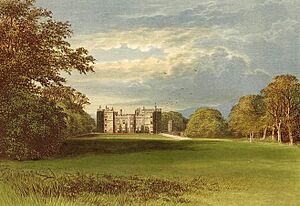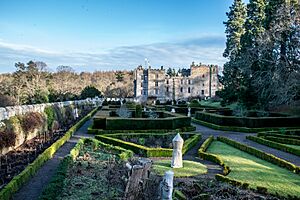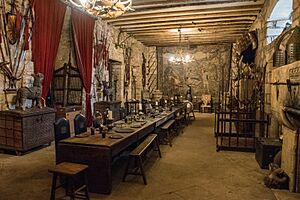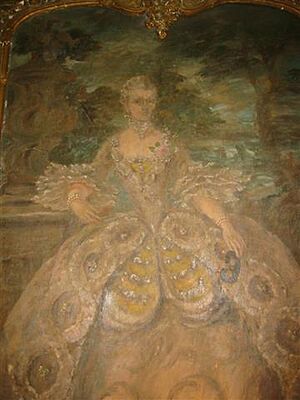Chillingham Castle facts for kids
Quick facts for kids Chillingham Castle |
|
|---|---|
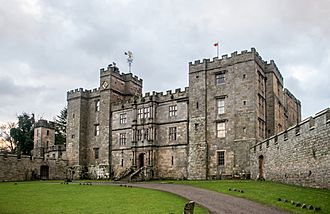
The north front
|
|
| General information | |
| Type | Castle |
| Location | Chillingham, Northumberland, England |
| Coordinates | 55°31′34″N 1°54′18″W / 55.526°N 1.905°W |
| Construction started | 12th century |
| Owner | Sir Humphry Wakefield, 2nd Baronet |
| Other information | |
| Number of suites | 8 |
Chillingham Castle is a very old castle located in the village of Chillingham in northern Northumberland, England. For many centuries, from the 1400s until the 1980s, it was the home of the Grey and Bennet families. Today, it is owned by Sir Edward Humphry Tyrrell Wakefield, 2nd Baronet, whose wife is related to the original Grey family.
The castle grounds include a large park where a very special and rare group of white cattle live. These are called Chillingham cattle, and there are about 130 of them.
Chillingham Castle is considered a very important historic building, known as a Grade I listed building. This means it's protected because of its special history and architecture. Some other old structures on the castle grounds are also protected as Grade II listed buildings.
Contents
History of Chillingham Castle
Chillingham Castle started out as a monastery in the late 1100s. In 1298, King Edward I visited the castle. He was on his way to Scotland to fight against a Scottish army led by William Wallace. A special window with glass was put in just for the king, which was very unusual for buildings back then.
A Border Stronghold
The castle was in a very important spot during the Middle Ages. It was right on the border between England and Scotland, two countries that often fought. English armies used it as a stopping point before going into Scotland. Scottish armies and raiding groups also attacked and surrounded it many times. The castle had a moat (a ditch filled with water) around it, and some of its walls were as thick as 12 feet (about 3.6 meters)!
In 1344, the castle was made even stronger. King Edward III gave permission for battlements (the notched tops of castle walls) to be built. This officially turned the stronghold into a fully fortified castle with a square shape.
From Fortress to Home
When England and Scotland became more peaceful, especially after King James I became king of both countries in 1603, the castle's role as a military fort changed. In 1603, Anne of Denmark, the Queen of Scotland, and her children stayed at the castle on their way to London. King James I himself stayed there in 1617.
As the need for a military stronghold lessened, Chillingham Castle slowly became more of a comfortable home. The moat was filled in, and the battlements were changed into parts of the living areas. A large banquet hall and a library were also added.
Later Changes and Decline
In the 1700s and 1800s, the castle's gardens and grounds were redesigned. Famous landscape architects like Sir Jeffry Wyattville worked on them. The large park that once belonged to the castle is now owned separately.
In 1872, the Prince and Princess of Wales stayed at Chillingham Castle while traveling to Scotland.
During the Second World War, the castle was used as a place for soldiers to live. It's said that much of the beautiful wooden decoration inside was taken out and burned by the soldiers for warmth. After the war, the castle started to fall apart. Lead was removed from the roof, which caused a lot of damage from rain and weather.
Restoration and Modern Use
The castle and its land stayed with the Earls of Tankerville until 1980. Soon after, the estate was divided up and sold. In 1982, Sir Humphry Wakefield, 2nd Baronet bought the castle. His wife, Catherine, is a descendant of the original Grey family who lived there. Sir Humphry began the careful work of restoring the castle.
In 1997, Chillingham Castle was used as a filming location for the movie Elizabeth. It appeared as "Leith Castle" and a hunting lodge in the film. The fake fireplaces from the movie are still in the great hall, covering up the real 18th-century marble fireplaces.
As of 2025, parts of Chillingham Castle are open for visitors. You can even go on late-night ghost tours! There are also eight apartments inside the castle and its other buildings that people can rent for holidays.
Chillingham's Ghosts
The current owners of Chillingham Castle say it is the most haunted castle in Britain. It has even been featured on the TV show Most Haunted. One of the most famous ghosts is the "blue (or radiant) boy." The owners say this ghost used to haunt the Pink Room in the castle.
Chillingham in Books
Chillingham Castle is mentioned in the novel The Bride of Lammermoor (1819) by Sir Walter Scott. In the book, it's noted as a place where a very old type of Scottish cattle could still be found. The castle and its cattle also inspired Eva Ibbotson's children's book from 2005, The Beasts of Clawstone Castle.
The castle is also the setting for the 2019 mystery novel “Ryan’s Christmas” by LJ Ross.
Gallery
-
Statue of Viscount Gough, relocated from Dublin
See also
 In Spanish: Castillo de Chillingham para niños
In Spanish: Castillo de Chillingham para niños


